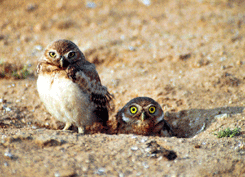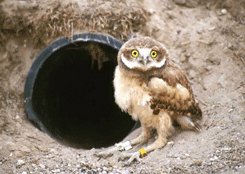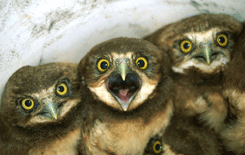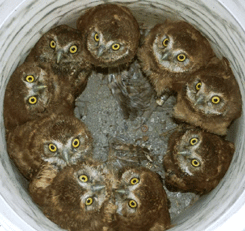Digging for Owls
Air Date: Week of August 11, 2006

The rare burrowing owl lives underground and has numerous vocalizations, including a call that mimics rattlesnakes to scare off predators. From southern Idaho, producer Jeff Rice reports on his trip with a biologist to dig for the tiny owls
Transcript
CURWOOD: Time now for a quiz. Owls live in A – trees; B – underground; C – both of the above. The correct answer is C. There is one species of owl, the burrowing owl, who prefers the underground. And that has led to some other unusual adaptations.
From Idaho, Jeff Rice has our report.
RICE: It's well over a hundred degrees out on the Snake River plain in southern Idaho and biologist Jim Belthoff is digging for owls.
[SOUND OF DIGGING]
RICE: This is a study site on the Snake River Birds of Prey National Conservation Area a few dozen miles from Boise. The vast expanse of tan colored soil and sagebrush has one of the densest populations of nesting raptors in North America. Today, we're hoping to find some rare burrowing owls.
[DIGGING]
BELTHOFF: The owls will be down here in this chamber...
RICE: Western burrowing owls are one of the smallest owl species and live in abandoned ground squirrel or badger holes in wide open areas like this one.

A baby burrowing owl and the entrance to its plastic burrow. (Photo: Dr. Jim Belthoff)
RICE: The field is next to a highway and seems barren. Mostly clay soil and hardly even any grass. Exactly the way the owls like it.
BELTHOFF: They like areas with very little vegetation. Little or none actually is what they prefer. And the reasoning is that they like no vegetation so that they can see any ground dwelling predators approaching their nest so they can get out of the way.
RICE: It's a strategy that works.
[OWL CALL]
RICE: A tiny brown and white adult owl no more than ten inches tall spots us. He rises up on a pair of spindly legs, sounding a warning call.
[SOUND OF CALL; DIGGING]
RICE: The rest of the owls are hunkered down, but we know right where to dig. Belthoff, a professor at Boise State University, has built some artificial plastic burrows. The owls have moved in and Belthoff can dig down to the lid and open the den up without too much trouble.
BELTHOFF: Some footprints in front of this one, so we'll probably find some babies in here.
RICE: Belthoff reaches his hand into the den to retrieve a bird and…suddenly…
[SOUND OF SNAKE RATTLE]
RICE: The sound is coming from inside the hole.
[RATTLING]
RICE: We know that this area is crowded with rattlesnakes, but Belthoff doesn't jump back. He reaches deeper into the hole, blindly feeling around.
[RATTLING]
RICE: He grabs something, coming out with a burrowing owl fledgling. The bird is about a month old. Its mouth is open and it is hissing at us.
[RATTLING]
BELTHOFF: Burrowing owls have about 17 documented types of vocalizations, of which this rattle call or hiss is one of them.
RICE: It's uncanny. Belthoff explains that it's something that only the juvenile owls will do. They haven't developed their ability to fly yet, so they need another way to ward off predators.
BELTHOFF: It's a case of what's called "mimicry" in animals in where either the site of something or the sound of something sounds like something else and, in this particular case, it's a case of Batesian mimicry where the sound of something that's harmless actually mimics something that's harmful.

A baby owl chick vocalizes. (Photo: Dr. Jim Belthoff)
BELTHOFF: There's a lot of rattlesnakes in holes and so any potential predator that's coming up on this hole and sneaking down the tunnel would actually think twice, perhaps, if he hears a rattlesnake in there. Certainly, I feel some trepidation when I reach my arm down in there and I hear those rattles, and I'm hoping it's not a rattlesnake.
[RATTLING]
RICE: The owl's mimicry is effective against predators like badgers, but it can't protect it from its biggest threat, bulldozers and creeping human sprawl. Burrowing owls are considered threatened or endangered in a number of western states. The owls tend to live on wide-open flat ground, a perfect place for shopping malls and parking lots.
[PASSING CAR]
RICE: That's why Belthoff is monitoring the birds, keeping track of their health and weight and tagging them to study their migration patterns.
BELTHOFF: We band each one with an aluminum leg band, and then we give them three color bands, so when they sit up on a perch we can actually read those colorband combinations with a spotting scope. And we can tell who it is we're dealing with without having to capture them.

Burrowing owl chicks in a bucket. (Photo: Dr. Jim Belthoff)
[DIGGING]
RICE: After the young birds are tagged, we cover up the owl den. An adult owl has been watching us from a fence post, probably the whole time, its call a bit less fearsome above ground.
[CHIRPING]
RICE: For Living on Earth, I'm Jeff Rice in southern Idaho.
[MUSIC: The Mighty Echoes "The Great Pretender" from ‘Doo Wop Til You Drop’ (Memphis International Records - 2003)]
Links
Living on Earth wants to hear from you!
Living on Earth
62 Calef Highway, Suite 212
Lee, NH 03861
Telephone: 617-287-4121
E-mail: comments@loe.org
Newsletter [Click here]
Donate to Living on Earth!
Living on Earth is an independent media program and relies entirely on contributions from listeners and institutions supporting public service. Please donate now to preserve an independent environmental voice.
NewsletterLiving on Earth offers a weekly delivery of the show's rundown to your mailbox. Sign up for our newsletter today!
 Sailors For The Sea: Be the change you want to sea.
Sailors For The Sea: Be the change you want to sea.
 The Grantham Foundation for the Protection of the Environment: Committed to protecting and improving the health of the global environment.
The Grantham Foundation for the Protection of the Environment: Committed to protecting and improving the health of the global environment.
 Contribute to Living on Earth and receive, as our gift to you, an archival print of one of Mark Seth Lender's extraordinary wildlife photographs. Follow the link to see Mark's current collection of photographs.
Contribute to Living on Earth and receive, as our gift to you, an archival print of one of Mark Seth Lender's extraordinary wildlife photographs. Follow the link to see Mark's current collection of photographs.
 Buy a signed copy of Mark Seth Lender's book Smeagull the Seagull & support Living on Earth
Buy a signed copy of Mark Seth Lender's book Smeagull the Seagull & support Living on Earth

